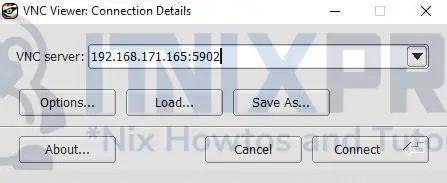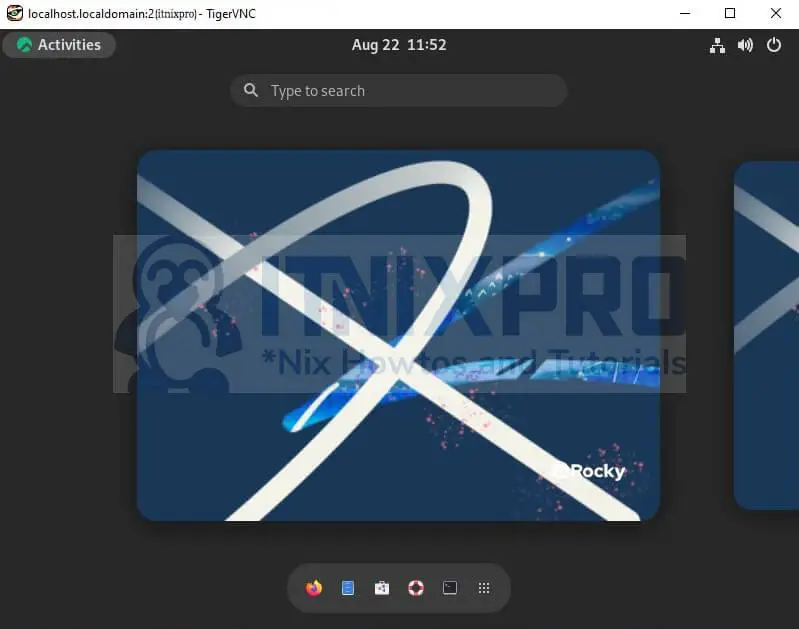This guide will take you through how to install VNC Server on Rocky Linux 9. Virtual Network Computing abbreviated as VNC is a graphical desktop sharing solution that enables you to control a distant computer by sending keyboard, mouse, and touch events to the VNC server.
How to Install VNC Server on Rocky Linux 9
- Update your system using the command below.
sudo dnf update- Install EPEL repository.
sudo dnf install -y epel-release- If you are using a server OS without GUI, install the desktop environment using the following command.
sudo dnf install @xfce-desktop-environment- Set default GUI.
sudo systemctl set-default graphical- Reboot your system to apply changes.
sudo reboot- Next, install TigerVNC which we will use in this example.
sudo dnf install tigervnc-server -ySample output
Dependencies resolved. ====================================================================== Package Arch Version Repository Size ====================================================================== Installing: tigervnc-server x86_64 1.11.0-21.el9 appstream 246 k Installing dependencies: dbus-x11 x86_64 1:1.12.20-5.el9 appstream 24 k tigervnc-license noarch 1.11.0-21.el9 appstream 16 k tigervnc-selinux noarch 1.11.0-21.el9 appstream 25 k tigervnc-server-minimal x86_64 1.11.0-21.el9 appstream 1.1 M Transaction Summary ====================================================================== Install 5 Packages Total download size: 1.4 M Installed size: 3.5 M Downloading Packages: (1/5): dbus-x11-1.12.20-5.el9.x86_64. 25 kB/s | 24 kB 00:00 (2/5): tigervnc-selinux-1.11.0-21.el9 121 kB/s | 25 kB 00:00 (3/5): tigervnc-license-1.11.0-21.el9 73 kB/s | 16 kB 00:00 (4/5): tigervnc-server-1.11.0-21.el9. 144 kB/s | 246 kB 00:01 (5/5): tigervnc-server-minimal-1.11.0 376 kB/s | 1.1 MB 00:03 ---------------------------------------------------------------------- Total 325 kB/s | 1.4 MB 00:04 Running transaction check Transaction check succeeded. Running transaction test Transaction test succeeded. Running transaction Preparing : 1/1 Installing : tigervnc-license-1.11.0-21.el9.noarch 1/5 Running scriptlet: tigervnc-selinux-1.11.0-21.el9.noarch 2/5 Installing : tigervnc-selinux-1.11.0-21.el9.noarch 2/5 Running scriptlet: tigervnc-selinux-1.11.0-21.el9.noarch 2/5 Installing : dbus-x11-1:1.12.20-5.el9.x86_64 3/5 Installing : tigervnc-server-minimal-1.11.0-21.el9.x86_ 4/5 Installing : tigervnc-server-1.11.0-21.el9.x86_64 5/5 Running scriptlet: tigervnc-server-1.11.0-21.el9.x86_64 5/5 Verifying : dbus-x11-1:1.12.20-5.el9.x86_64 1/5 Verifying : tigervnc-server-minimal-1.11.0-21.el9.x86_ 2/5 Verifying : tigervnc-server-1.11.0-21.el9.x86_64 3/5 Verifying : tigervnc-selinux-1.11.0-21.el9.noarch 4/5 Verifying : tigervnc-license-1.11.0-21.el9.noarch 5/5 Installed: dbus-x11-1:1.12.20-5.el9.x86_64 tigervnc-license-1.11.0-21.el9.noarch tigervnc-selinux-1.11.0-21.el9.noarch tigervnc-server-1.11.0-21.el9.x86_64 tigervnc-server-minimal-1.11.0-21.el9.x86_64 Complete!
- Add VNC service to your firewall.
sudo firewall-cmd --add-service=vnc-server --permanent- Reload your firewall.
sudo firewall-cmd --reload- Set the VNC password using the command below.
vncpasswdSample output
Password: Verify: Would you like to enter a view-only password (y/n)? n A view-only password is not used
- Create a VNC config file using the command below.
sudo nano ~/.vnc/configPaste the configuration below into the file created above.
# create new # session=(display manager you use) # securitytypes=(security options) # geometry=(screen resolution) session=gnome securitytypes=vncauth,tlsvnc geometry=800x600
- Open the VNC users configuration file using the command below.
sudo nano /etc/tigervnc/vncserver.usersThen enter the display number with the user as in the example below.
## TigerVNC User assignment # # This file assigns users to specific VNC display numbers. # The syntax is =. E.g.: # # :2=andrew # :3=lisa :1=demouser :2=itnixpro
- Start the VNC server and enable it to run on boot.
sudo systemctl enable --now vncserver@:1 vncserver@:2Configure VNC Client
- Open your VNC client, then enter the VNC server IP address followed by port 5901 for display one, port 5902 for display two and so on in that order.

- To get your VNC server IP run the command below on Rocky Linux 9 running your VNC.
ip a- After hitting the connect button you will be prompted to enter your VNC server password as shown below.

- You will be able to access the machine running the VNC server after successful authentication as shown below.

- That marks the end of our article. we have gone through how to install VNC Server on Rocky Linux 9.
Read more about TigerVNC
Other Tutorials
Install VNC Server on OpenSUSE
